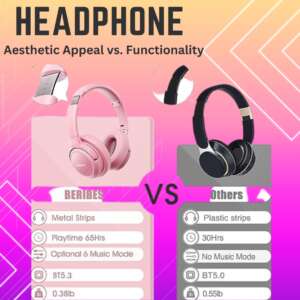
Pink wireless headphones have gained an excessive amount of attention and praise, but their overrated status is undeniable. Firstly, the color alone seems to be a major selling point. Overshadowing more important factors such as sound quality and functionality. Many consumers are drawn to the aesthetic appeal rather than the actual performance of these headphones.
In a world inundated with flashy gadgets and tech accessories. One trend that seems to have taken the market by storm is the craze for pink headphones.
This article delves into the realm of wireless headphones and uncovers seven reasons why they are, in fact, completely overrated. From questionable sound quality to limited versatility. The allure of these rosy-hued audio devices might just be masking their true shortcomings.
Walking down the streets, it’s hard not to notice the profusion of individuals sporting these bubblegum-colored wireless headphones. Advertisements often depict these headphones as the epitome of style and sophistication, but are they worth the investment?
While the trendy appearance might be a crowd-pleaser, it’s important to move beyond aesthetics. Evaluate the actual performance of these headphones. Beneath the surface-level attraction lies a myriad of issues that manufacturers and marketers conveniently sweep under the rug. It’s a stark reminder that aesthetics should never come at the expense of performance.
Aesthetic Appeal vs. Functionality
Pink headphones have become a symbol of aesthetic appeal over functionality. Leaving many consumers to question whether the hype is truly warranted. While their vibrant hues and trendy designs might catch the eye. These headphones often fall short in terms of actual performance.
Aesthetic appeal can only take you so far. When it comes to audio quality and functionality, wireless headphones tend to underdeliver. Consumers should be cautious not to prioritize style over substance. A pretty exterior doesn’t necessarily translate to a superior listening experience.
One major drawback of wireless headphones is their tendency to sacrifice sound quality for the sake of appearance. Manufacturers often invest more effort into creating an eye-catching design than in engineering superior audio components.

As a result, these headphones might lack the crispness, depth, and balance that audiophiles seek. The emphasis on aesthetics can lead to compromises in driver quality, frequency response, and noise cancellation capabilities.
Ultimately, users may find themselves disappointed by the lackluster audio performance. Making them question whether the stylish exterior was worth the sonic sacrifice.
Another area where Pink wireless headphones can be overrated is durability and build quality. While they may look stunning on the shelf. Many of these headphones rely on delicate materials that might not stand up to the rigors of daily use.
Flimsy construction and lightweight materials might contribute to a shorter lifespan and susceptibility to wear and tear. The pursuit of style can sometimes lead to headphones that are more prone to breaking. Which is a major inconvenience for users who rely on their headphones for regular activities like workouts or commuting.
As consumers, it’s important to strike a balance between aesthetics. Functionality to ensure that the headphones not only look good but also hold up well over time.
Limited Gender Stereotyping
Pink headphones have become synonymous with the idea of gender stereotyping. Perpetuating the outdated notion that certain colors are exclusively for a particular gender.
It suggests that women should be drawn to dainty. Feminine aesthetics, while men are expected to prefer more “masculine” designs. This approach completely disregards the diverse preferences and interests of individuals. Fostering a culture of conformity rather than celebrating individuality.
By pigeonholing pink as the default color for women’s headphones, manufacturers miss out on the opportunity to offer a broader range of options that cater to a wide spectrum of tastes.
Promoting Gender Equality
Another reason why pink wireless headphones are overrated is the potential compromise in quality and functionality in favor of aesthetics. Some manufacturers might focus more on design and color while sacrificing sound quality, battery life, and other essential features.
This compromise does a disservice to consumers who deserve both style and substance in their tech products. By perpetuating the idea that appearance matters more than performance, the market inadvertently encourages a shallow approach to technology purchases, where consumers might prioritize looks over actual utility.
Corporate Gender Diversity
Furthermore, the push for Pink wireless headphones detracts from the broader issue of representation and inclusivity within the tech industry. Rather than addressing the real challenges faced by underrepresented groups in the field, such as women and minorities, the industry might mistakenly believe that slapping a pink coat of paint on a product is sufficient to cater to these demographics.

In reality, what’s needed is a deeper commitment to diversity in design, marketing, and product development, rather than relying on gendered colors to create a façade of inclusivity. True progress in the industry involves breaking free from such token gestures and embracing a more holistic approach to addressing systemic imbalances.
Lack of Technological Advancement
Pink headphones have undeniably become a fashion statement, but their popularity often overshadows their lack of technological advancement. While they might be eye-catching and stylish, many Pink wireless headphones on the market lag behind their more subdued counterparts when it comes to innovative features.
The focus on aesthetics seems to have taken precedence over incorporating cutting-edge technology. This results in a missed opportunity for users who seek enhanced sound quality, noise-cancellation capabilities, and seamless connectivity that these headphones often fail to deliver.
Manufacturers often prioritize the outer appearance of these headphones, leaving the internal components lacking in terms of delivering a well-balanced and immersive audio experience.
In comparison to other models designed for audio enthusiasts, the emphasis on pink aesthetics can lead to compromised sound dynamics, disappointing bass reproduction, and overall audio fidelity.
This compromise between looks and performance leaves discerning users unsatisfied, as they have to sacrifice audio quality for a rosy appearance.
Furthermore, the obsession with the pink color scheme often overshadows the need for technological innovation such as advanced noise-cancellation features. Many users expect their wireless headphones to provide a sanctuary from the noise of the outside world, allowing them to fully immerse themselves in their music or calls.
However, a significant portion of wireless headphones lack the state-of-the-art noise-cancellation technology that can be found in other neutral or performance-focused models. This disregard for technological advancement limits the potential use cases of these headphones and ultimately fails to meet the diverse needs of modern consumers.
Durability Concerns
Pink wireless headphones have undeniably become a fashion statement, often overshadowing their practical attributes. Manufacturers tend to prioritize aesthetics over sturdiness, resulting in flimsy constructions that are prone to breakage.
The emphasis on the pink color and sleek design often leads to the neglect of crucial structural components, leaving consumers with headphones that have a shorter lifespan.

In a world where technology is expected to withstand the test of time, wireless headphones often fall short, leaving users frustrated by their lack of durability and the need for frequent replacements.
Environmental Factors
Another aspect contributing to the overrated nature of pink wireless headphones is their inflated price tag. Often marketed as luxury items due to their fashionable appearance, these headphones tend to come with a premium price, far exceeding their actual technological capabilities.
The lure of the pink hue and the brand name can blind consumers to the fact that they are paying more for style than substance. Comparable headphones in other colors may offer the same or even superior audio quality and features at a fraction of the cost.
Prioritizing aesthetics over functionality can lead to regrettable purchases, leaving consumers feeling that they paid too much for the perceived prestige of pink headphones.
Long-Term Performance
Moreover, the marketing hype around pink wireless headphones can mislead consumers about their audio performance. While some of these headphones might look the part, their sound quality often fails to match expectations.
Manufacturers capitalize on the popularity of pink headphones by focusing on their appearance and skimping on advanced audio technology. This results in lackluster sound reproduction, with compromised bass, muddled mids, and underwhelming highs.
Those seeking an immersive and high-quality audio experience might be sorely disappointed by the subpar performance of these overrated headphones. In the end, choosing wireless headphones solely for their color and style can lead to sacrificing audio excellence for aesthetics.
Market Trend Manipulation
In today’s consumer-driven market, the phenomenon of “Market Trend Manipulation” has led to the rampant overrating of wireless headphones. While they may initially seem like a fashionable accessory, closer examination reveals that these headphones are often overhyped and fail to deliver on their promises.
One of the main reasons these headphones are overrated is their color-centric marketing strategy. Manufacturers focus on the aesthetic appeal of the pink color, manipulating consumers into believing that a trendy hue automatically translates to superior functionality.
Moreover, the emphasis on the pink color distracts consumers from the lackluster features that often come with these headphones. These products tend to compromise on sound quality, comfort, and durability in favor of their flashy appearance.
This trend manipulation preys on consumers’ desire to stay up-to-date with the latest fashion trends, leading them to prioritize style over substance. As a result, users may end up with headphones that not only fail to provide an immersive audio experience but also prove to be uncomfortable during prolonged use.
Another significant issue with these overrated wireless headphones is their inflated pricing. Manufacturers capitalize on the popularity of the color trend to mark up the price, exploiting the psychological connection consumers have with trendy items.
Consumers often pay a premium for the “pink” branding rather than the actual technology within the headphones. This price inflation further underscores the market trend manipulation that fuels the overrating of these products.
In reality, consumers would be better off investing in headphones that prioritize performance and functionality over superficial trends, ensuring a worthwhile and lasting audio experience.
Neglected Audio Quality
One of the most glaring reasons why Pink wireless headphones are overrated is the consistent neglect of audio quality by manufacturers who prioritize aesthetics over substance.
While the eye-catching pink color might appeal to many users, it often comes at the cost of subpar sound performance. Manufacturers tend to focus more on the visual design, leaving the audio components and engineering to take a backseat.

This results in headphones that look trendy but fail to deliver the immersive and rich audio experience that discerning users expect. It’s disappointing to invest in a pair of headphones that prioritize style over the fundamental purpose of delivering high-quality sound.
Superficial Branding:
Pink wireless headphones often seem to be marketed as fashion accessories rather than serious audio equipment. Manufacturers frequently leverage the popularity of certain color trends to attract a specific demographic, making it appear that the primary selling point is the color rather than the headphone’s technical capabilities.
This superficial branding can lead buyers to believe they are getting a premium product simply because of the pink color, while in reality, the headphones might lack advanced features, noise-canceling technology, or a balanced sound profile that more dedicated audio brands offer. As a result, users may be disappointed by the underwhelming performance of these overhyped headphones.
Shortened Lifespan:
The pursuit of creating eye-catching Pink wireless headphones sometimes results in a compromise on build quality and durability. Manufacturers might cut corners to maintain a competitive price point, leading to headphones that are more prone to wear and tear over time.
This can be particularly frustrating for consumers who expect their investment to provide long-lasting value. While the headphones may look attractive initially, the allure fades quickly when users realize that the flimsy construction and lack of durability compromise their overall experience.
In contrast, headphones from established audio brands tend to prioritize both aesthetic appeal and robust engineering to ensure a longer product lifespan.
Alternatives Worth Considering
For those seeking a balance between aesthetics and performance, there are several alternatives worth considering that offer better value for your money. One such option is neutral-colored headphones from reputable brands that prioritize sound quality and durability.
Brands like Sony, Sennheiser, and Bose offer a wide range of headphones that come in understated yet elegant designs, without compromising on audio excellence.

Another route to explore is customizable headphones that allow you to change the ear cup covers or bands according to your preferences. This way, you can enjoy the benefits of wireless headphones without being stuck with a single color choice.
Additionally, exploring smaller, innovative brands can lead to the discovery of headphones that prioritize both style and substance, often at a more reasonable price point than their overrated pink counterparts.
FAQs
1. Are pink wireless headphones suitable for all ages?
Pink wireless headphones come in various styles, making them suitable for all age groups. Whether you’re a teenager or an adult, there’s a pink headphone design that can match your preferences.
2.Do pink wireless headphones cost more than standard colors?
The price of pink wireless headphones is typically in line with headphones of other colors. It ultimately depends on the brand and features, not the color.
3.Can I use pink wireless headphones with non-pink devices?
Absolutely! Pink wireless headphones are compatible with a wide range of devices, regardless of their color. They connect via Bluetooth, ensuring seamless compatibility.
4.Do pink wireless headphones have good battery life?
Many pink wireless headphones offer excellent battery life, often on par with headphones of other colors. Be sure to check the specific model’s specifications for details.
5.Are pink wireless headphones only for women?
Pink wireless headphones are for anyone who appreciates the color and its style. They are not limited to any gender and can be enjoyed by all.
Conclusion
In conclusion, while Pink wireless headphones might seem enticing with their trendy appearance and the promise of convenient wireless technology, they are ultimately overrated for a variety of reasons.
The flashy pink color might attract attention, but it does little to enhance the actual audio quality or functionality of the headphones. Investing in headphones solely for their color might lead to disappointment when the audio experience falls short of expectations.


